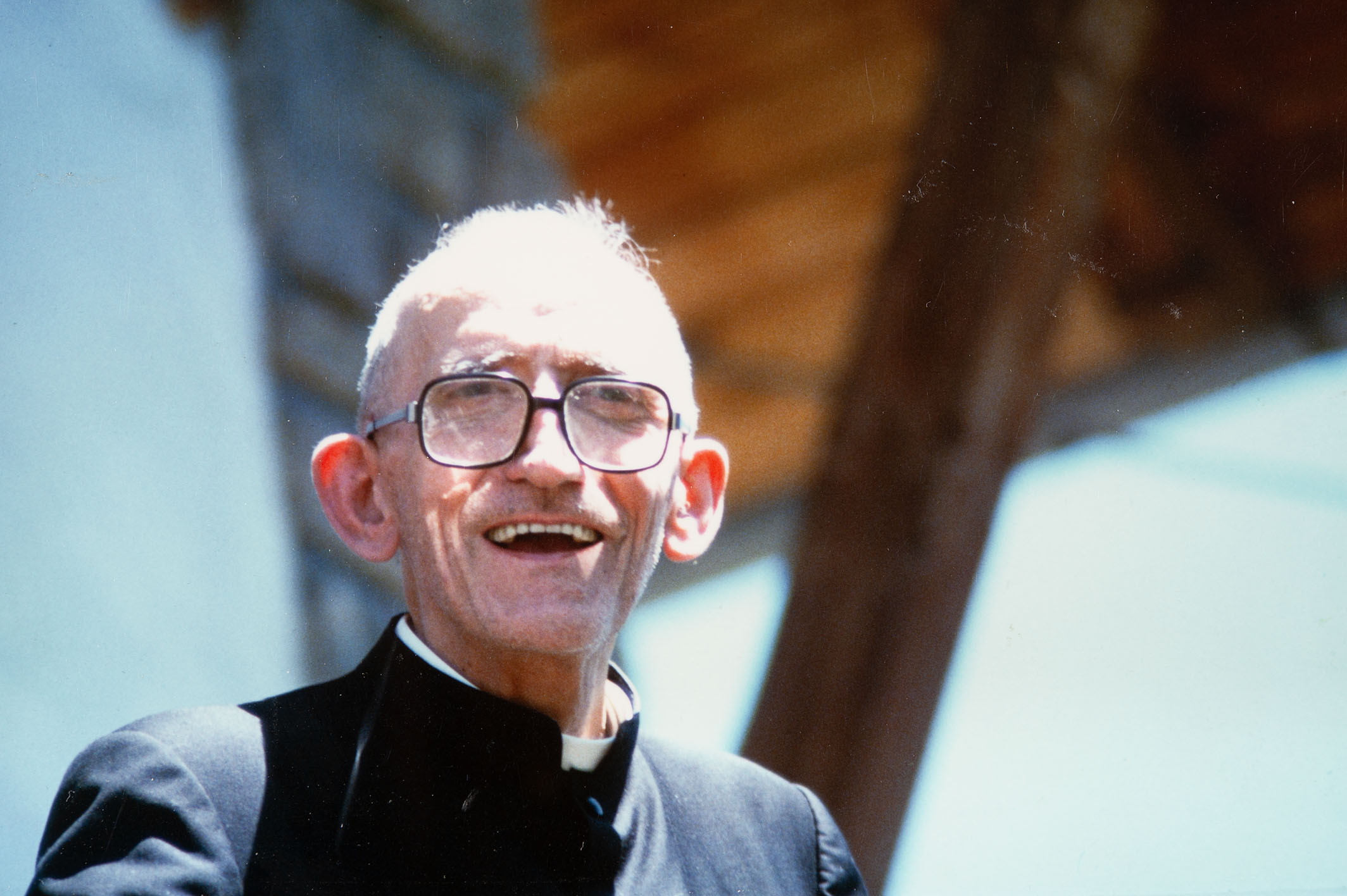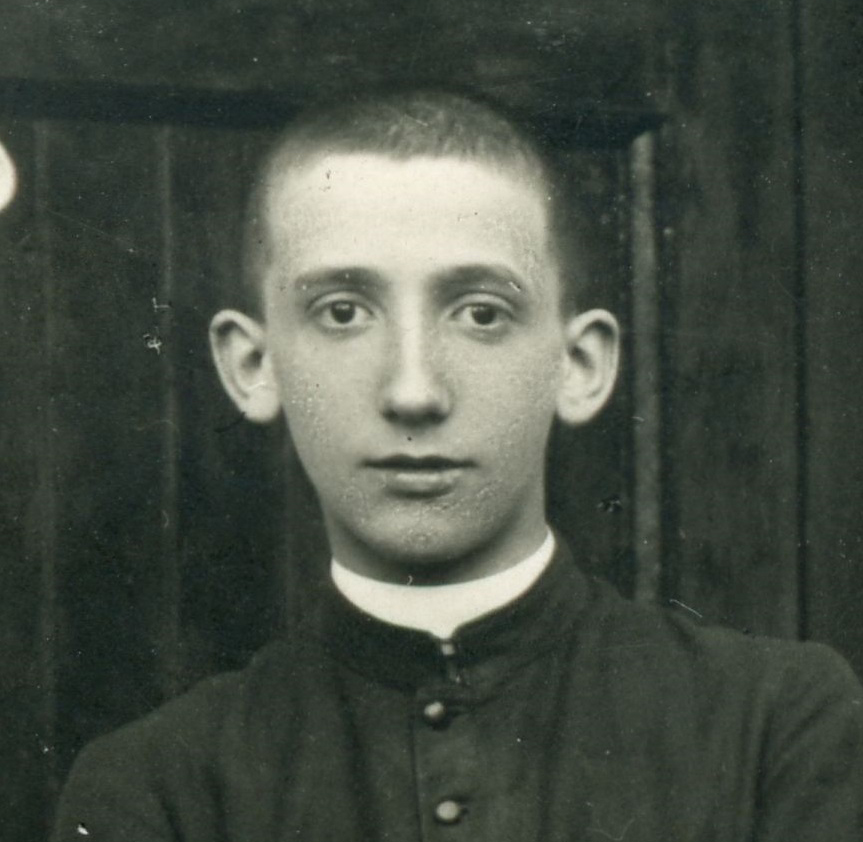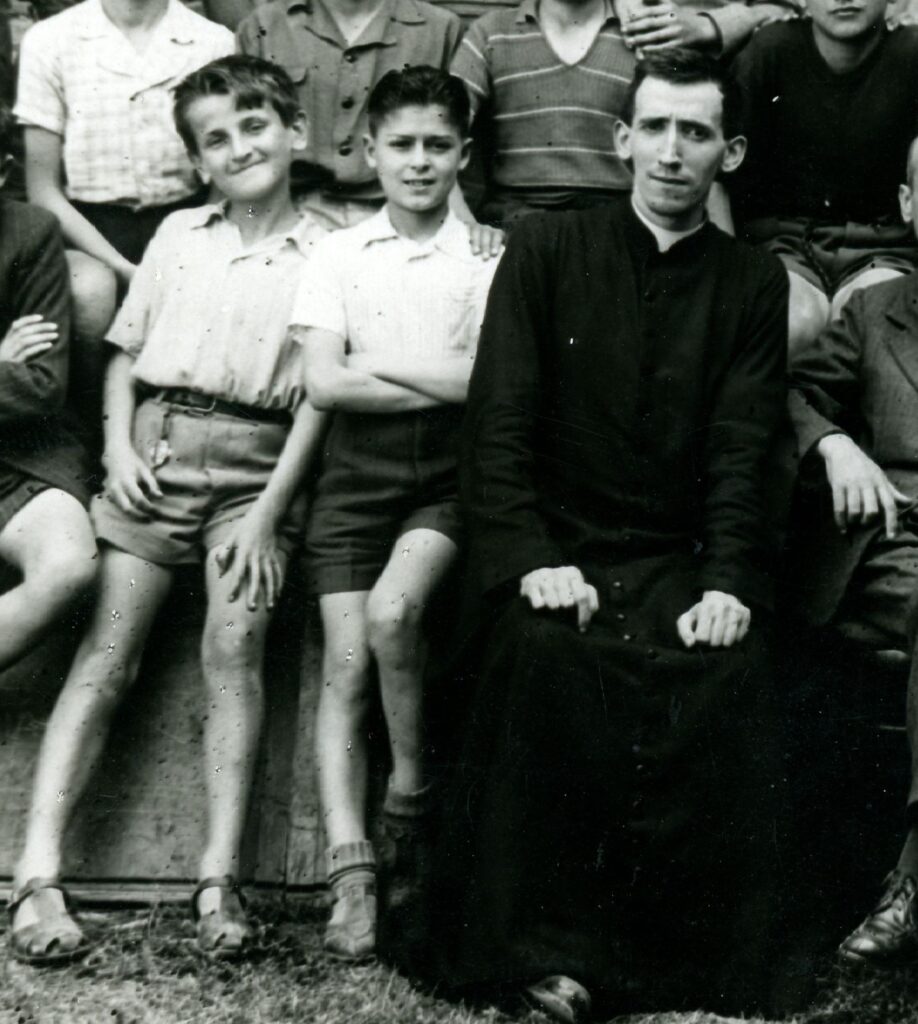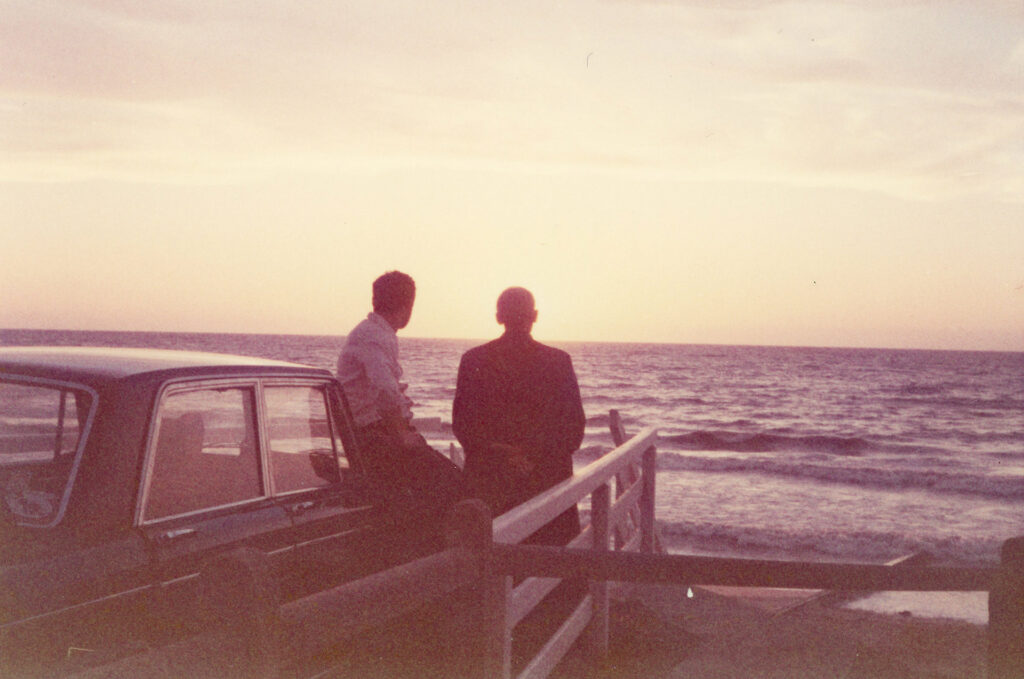
Select the chapter to view
Pietro Margini was born in Sant’Ilario d’Enza on January 5, 1917. He was the third of four brothers: Fanny, the eldest; a boy, who survived a few hours; and finally Maria Teresa, the little one, to whom he was linked by particular affection and complicity.
Even before his birth, in front of the image of Our Lady of Mount Carmel, venerated in the town church, he was consecrated by his mother to become a priest. He was baptized on January 23, 1917.

Fr. Pietro at one year of age, in the arms of mother Emilia
Young Pietro often spent his summer holidays in Casalgrande with his uncle Fr. Aldo, the town's parish priest. Here the natural family bond that existed between them gradually developed into something more. Fr. Pietro himself, a few years later, on Christmas 1936, wrote to his uncle: “It comes to me more spontaneously and as a need my grateful prayer to the Lord, for you who set me off, guided me, supported me in my vocation, from childhood until now. […]. I recommend myself, most reverend Archpriest, to your prayers, especially these days. I feel in great need of prayers and it seems to me that the most powerful prayer is that of fathers for children they have nurtured and raised in the way of the sanctuary”.
During one of these stays in Casalgrande, in the summer that marked the end of elementary school, Pietro received a letter from his father Dante, informing him that he had enrolled him in a technical school so that he could eventually become an accountant. Pietro’s answer was firm: he wanted to go to high school, because he wanted to become a priest.
In October 1928, Pietro started attending high school at the seminary of Reggio Emilia; he then continued his high school studies in Marola and finally in Albinea, where he completed his education with four years of Theology. In Albinea he was appointed Prefect of about twenty young high school seminarians; in 1939, on July 30 he received the major order of subdeacon, followed by diaconate on September 23.
Due to the dramatic international situation, the superiors of the seminary sped up the schedule for the ordinations of students in the final year, so on June 9, 1940 Pietro was ordained a priest by Monsignor Eduardo Brettoni, bishop of Reggio Emilia. On June 13 he celebrated his first Mass in Casalgrande, in his uncle’s parish and on June 16 he officiated the Eucharist for the first time in his hometown.

Pietro as a young seminarian, 1935. On vacation in Casalgrande with his uncle Fr. Aldo.
In September 1940, Fr. Pietro was appointed Coadjutor of Monsignor Giuseppe Bonacini in the parish of Saints Quirinus and Michael in Correggio, where he arrived on October 7. He was entrusted with the direction of the boys oratory and the group of Aspirants and, at the same time, he started teaching Religion in the State Middle School and in the Technical Institute in Correggio.
This was the beginning of his pastoral work among the youth: his daytime was entirely dedicated to his spiritual children; his nighttime to personal study, reading and praying.
The courtyard of the "old rectory", the altar and the confessional became everyone’s points of reference.
His delicate constitution was affected: despite the warning signs, he neglected himself.
In December 1941 he was forced to be hospitalized due to pleurisy. But another concern was afflicting him even more: his father Dante was also seriously ill and on March 21, 1942 he died. Fr. Pietro wished to keep the family united: in December, his mother Emilia and his sister Maria Teresa moved to Correggio and went to live with him in the "old rectory" near the church of San Quirinus.
His health became frailer and frailer: in the winter between 1943 and 1944 he was seriously ill again; he went to St. Sebastian hospital in Correggio but to the doctors his cause was desperate. On the evening of February 20, 1944 they said that the young priest would not survive the night. Many years later, he would say: “What passed that night only the Lord knows... but Our Lady passed”.
On August 14 he was discharged from the hospital and began a very long convalescence. After almost two years, Fr. Pietro could finally resume his pastoral activity.
Starting October 1946, he accepted the position of Assistant of the two branches, male and female, of the Catholic Action of Correggio and, the following year, that of Religion teacher in the local high school Liceo Classico "Rinaldo Corso". In the same year he was given the rectorate of the church of St. Francis in Correggio and there he moved, with his sister and mother.
He had a very intense relationship with the diocesan Catholic Action center, while the new bishop, Beniamino Socche, involved him in the spiritual formation of seminarians and clergy through the preaching of spiritual exercises and retreats. His preparatory notes show pure enthusiasm and awareness of the greatness of his vocation; this is what he wrote: “In a short time you will be priests: everything is said. […]. He will soon give you his powers, his treasures: souls. Let Him shape you in the feelings, in the virtues. Disappear: that is the watchword. The world does not need men, even if they are good, honest or learned; the world needs Him. […]. To be an instrument capable of giving Him, of spreading Him, of making Him radiate, it is necessary to live an intimate life with Him, heart to heart. […]. The more generous you are, the more Jesus Christ will have the freedom to act within you and consequently to make you saints and sowers of holiness. […].
We are called by election and by vocation to holiness. It is necessary to become saints. It is a grace to become saints. It is good to become saints.
Our life is useless if we don't. Damaging, actually. […].
There is one categorical imperative: holiness.
Everyone asks for holiness, the world wants nothing more from us. We need to throw ourselves into holiness. At all costs, under all conditions. […] A multitude of souls ask you for it: the children who are already waiting for you, the young. There are parishes that await a holy priest, souls who will be saved from hell if you become saints, vocations and perfections that will flourish. […] Make yourselves saints. Otherwise you would waste the distinguished grace of your ordination”.
The strong passion for the education and formation of Christian people led him in 1948 to be the promoter and founder of the secondary school "San Tomaso d'Aquino", of which he was appointed vice-principal and where he taught religion, keeping up the fruitful collaboration with the tertiaries of the Dominican Cenacle, responsible for the “Contarelli” Conservatory, of which he had become spiritual director in September 1942.

Fr. Pietro among his students of the state middle school, class 1946-1947. On the left, Romano Onfiani, future lay leader of the communities
Thus, through the life of the oratory and especially through school teaching, Fr. Pietro came across most of the youth of Correggio.
He began an innovative apostolic work with young people, bringing them closer to prayer, the Eucharist, the sacrament of Reconciliation.
Fr. Pietro met the Catholic Action groups regularly. The “meetings” were strong formation moments: they talked, discussed, shared views in order to acquire a shadowless vision of life and faith and be true Christians, witnesses of Christ in ordinary life. He often engaged in dialogues with young people until after midnight, but above all he gave his time to listen to and bring souls closer to the Lord through spiritual direction and spiritual exercises.
Young people realized that there was something different in this priest, something that made the deepest strings of their heart vibrate. Fr. Pietro was extraordinarily charming to each soul, with the charm of free and unconditional love. Everyone felt unique, special, a favorite, and, for this very reason, ready for arduous and difficult undertakings. Fr. Pietro was aware of this and did not hesitate to point towards a compromise-free Christianity, a lifestyle characterized by assiduous and authentic sacramental life.
After reading and meditating on Pius XII's encyclical Mystici Corporis Christi and reflecting on pastoral needs, in the mid-1950s Fr. Pietro proposed to the young people close to him an ideal of a "high standard" Christian living, inspired by the communities of the first Christians. In 1957, in Correggio, the first small community was born, made up of engaged couples who would soon be married.
In 1957 one among the young men around Fr. Pietro saw in his words a special intuition, a new proposal, coming from the same reading and meditation of the Mystici Corporis Christi and from the reflection on the same pastoral needs. It was the need of a return to the origins and to live Christianity as the first Christian communities, following the ideal of the Beatitudes. Fr. Pietro made an invitation to his young sons and daughters, to the couples who were getting together and who would become families; an invitation not to close in on themselves, to make friendship their guarantee and guardian of their own fidelity to Christ.
Thus, the first small community of families was born. Months of intense and exciting work began.
Then, suddenly, an unexpected turn. His bishop, Beniamino Socche, invited him to participate in the competitive examination held for the vacant place in the parish of St. Eulalia, in his hometown.
He accepted this unforeseen request obediently. In July 1960 he passed the examination and became the new pastor of Sant’Ilario.
The young people of Correggio accompanied him as he entered the new parish: it was August 28, 1960.
Bishop Benjamin Socche introduced him to the new ministry with prophetic words: “Deo gratias et Mariae! Sant’Ilario has his new Pastor, who is exuberant with apostolic and priestly life. He is mainly the apostle of the young: he is the apostle who knows no rest in his pastoral work and who knows how to use even a precious minute to spend it for souls.
You will see, dear sons and daughters of Sant’Ilario, your new Archpriest absorbed by the solicitude of responding to the needs and requests of your beautiful and vast parish.
You will see him taking direct care of your souls in parish life, in the daily service of the Priest at the altar, on the pulpit, in the Confessional, teaching, among the youth, at the bed of the sick, in personal meetings. Especially you, young people, will find in your new Archpriest a big heart, truly open to understand you, to love you. […].
But we know what these words mean. The price is sleepless nights, uninterrupted evenings of continuous conversation and deep spiritual meetings with young people; it is constant and patient attendance to the Confessional at all hours of the day; it is the whole and entire life of a Priest who has been able to renounce any entertainment, television, trips, travels, useless visits and even pilgrimages and all his own and particular interests in order to be everything and always for his young people. O children of Sant’Ilario, you will one day know the predilection that the Lord Jesus Christ had for you by giving you this new Shepherd”.
Now it was all about rearranging everything and starting over. His mother was with him and his sister Maria Teresa, with her husband Enzo, moved from Sanremo to be there.
New collaborators began to approach him timidly; young people, however, were just a few... But his heart and passion for souls, which he had shown in Correggio, little by little conquered the young people who began to join in moments of formation, go to Confession, and go on summer camps together.
It was the beginning of a new and fruitful pastoral season at the service of the entire population of Sant’Ilario. In fact, Fr. Pietro did not hesitate, already in 1961, to lend the "Casa della Dottrina Cristiana" (the parish rooms used for catechism) for free, either to start the experience of a state middle school (which the town of Sant'Ilario did not have yet), and to welcome children in the afternoon for an after-school service.
In the summer of 1962 he proposed the first girls camp in Entrèves, with another parish group from Casale Monferrato. The summer camp experience was eventually extended to the boys, and would increasingly become the central moment of the year, during which teenagers and young adults could grow in human skills, the communion of friendship and the life of faith. Sant’Apollonia (BS), Sachet (BL), Gosaldo (BL), Teveno (BG), Morge (AO) were places where youth groups flourish.

Fr. Pietro in France, contemplating the Atlantic Ocean for the first time, 1972
Mother Emilia died on November 21, 1964. For Fr. Pietro this was a great suffering, made bearable by the certainty of eternal life. In the parish register he wrote: “Christus te, in luce, mater mea fortis et suavissima. Beatae Mariae Virgini de Carmelo me puerum consecrasti ab initio ut sacerdos fierem et longo labore complevisti”.
These were the years of the Second Vatican Council: Fr. Pietro shared the passion that accompanied this ecclesial season; he studied the instances and documents that would inspire his new ministry in depth and with wise discernment.
Some couples from Correggio, who in the meantime had become families and had formed other small communities of families, felt the call to share the path already begun with him: in 1966, they chose to move to Sant’Ilario d’Enza. Under his guidance, in the early 1970s, they started being involved in cycles of catechetical meetings on baptism for parents and one on marriage for couples preparing to be married.
Wonder, amazement, hilarity characterized these years. The parish community began to reflect more on itself and to understand the revolutionary idea of its parish priest: priest and families, united by the same ideal in a relationship of real collaboration, were dedicated to building the Kingdom of God through mutual help. In fact, families could participate together with priests in the mission of the whole Church and priests could collaborate with families for the human and Christian growth of spouses and their children.
The example of the small communities from Correggio was contagious: more young men and women from Sant’Ilario embarked on this experience.
In October 1974 the Pastoral Council identified some main apostolate fields and twelve specific commissions were set up to reach the whole community of Sant’Ilario. Parish life came alive with catechism for children and formative meetings for young people and adults. It was supported by an intense liturgical life, its pace given by monthly retreats and annual spiritual exercises.
The protagonists of this adventure were the young people and the small communities of families. Fr. Pietro gave them responsibilities in many pastoral activities. Some worked as youth ministers or catechists, some as sports coaches, some as cooks, some as bursars; many opened their homes to allow young people to meet in a domestic and homely environment where they could share thoughts and grow in friendship. On June 19, 1977, Bishop Giberto Baroni inaugurated a new oratory dedicated to St. John Bosco.
Families were also at the heart of the great project of creating a school. They gave time and professional advice to create an environment where Christian culture and formation could spread. Eventually, in 1971, the Scuola Magistrale was founded, followed by the "San Gregorio Magno" Institute in 180, a Parental Elementary School in 1983, a parish Kindergarten dedicated to St. Joseph in 1985 and a Parental Middle School in 1988.
Thanks to the active collaboration of vicars and lay people, who were responsible for several aspects of parish life, Fr. Pietro's could focus on one main activity: taking care of souls. He spent most of his time at the altar, in the confessional or in his study, where he met groups of teenagers, young people and adults who, over the years, had grown in the parish.
Alongside the pastoral activity of the parish, Fr. Pietro continued to closely follow the development of the small communities of families which, over time, became more and more numerous. In the 1970s, he had already invited the small communities to feel part of a "Community that is one" to experience the Church and give testimony of it, as a communion of people and God’s family. He organized plenary meetings in which he clearly outlined the purposes of the small communities: "Three points; form communities of families: first, to build one's holiness in the grace of the sacrament of marriage; but the family is not alone, it must feel the second commitment: friendship! This is why we are structured like this, because friendship came from the very Heart of Jesus who wanted us together. And, then, the third, but not the least, point: to sanctify the other families; so, an evangelical life of commitment!". At the same time, he outlined a precise, more general, path: “Tonight even the youngest must deeply feel that the subject of Community is not the fraternity of some, it is a movement in the Church, it is a movement that has a great purpose […]. The community movement is a movement of renewal and holiness”; and again: “Say that we are a new Movement? I dare not say it! Say that we do something our own, original, not that we are the best, but that we follow a path that the Lord has shown us step by step, day by day: yes!”.
During these years Fr. Pietro inspired the work for the drafting of a "Statute for the communities of families".
The parish community and the small communities of families contributed to building the Church in Sant'Eulalia as a family of God, a place where "the life of others has become “my” ,”my” interest, “my” joy, “my” own life […] where mine and yours have become a single reality”.
In this new reality everyone found their place; as if part of a large family, everyone rejoiced and suffered for the same things. Sharing was supported by a lively love for the "father" of the Community: his example was irresistible, his heart disarming, his self-giving tireless. His children generously responded to another intuition: from the mid-70s on, Fr. Pietro was a promoter and supporter in the diocese of Reggio Emilia-Guastalla, together with Fr. Altana, Fr. Torreggiani and Fr. Prandi, of the restoration of permanent diaconate.
For Fr. Pietro, the permanent diaconate represented the sacramental seal of a characteristic of the people of God entrusted to him. A people who followed Jesus, who came "not to be served, but to serve". Thirteen deacons sprang from the community of Sant’Ilario: the first seven were ordained on Holy Thursday 1978; the other six, on June 25, 1983.

Fr. Pietro surrounded by families on the day of the act of entrustment to Mary. June 19, 1988
The 80s were characterized by the birth of countless families and many children. But above all they were marked by a profound joy: the first vocations to priesthood flourished among Fr. Pietro’s spiritual children. In fact, three boys entered the diocesan seminary of Reggio Emilia. Fr. Pietro attended the presbyteral ordination and concelebrated the first solemn Mass of the first of them in 1987, and was also with the second one for the celebration of his first Mass in 1989. “The community of the Seminary” was born and Fr. Pietro clearly saw it as belonging in a unitary project: “Your community is part of the Community Movement which arose in 1957-59 after the Mystici Corporis”.
The last years of his life were very intense despite a decline in his strength: in 1987 he preached at twenty-six of spiritual exercises courses. In 1988 he also began the restoration of the parish church of Sant’Eulalia. On June 19 Fr. Pietro's great dream came true: a hundred families were consecrated to Christ through the hands of Mary, according to the teaching of St. Louis Marie Grignion de Montfort.
The preparation for this event, according to his style, was long and deep. It was the greatest tribute he could offer to the Heavenly Mother, whom he had always loved and inspired to love.
For this reason, he had previously given new impetus to the Confraternity of the Blessed Virgin of Mount Carmel, imposed the Miraculous Medal on many young people, urged the spread of the practice on the first five Saturdays of the month, the praying of the rosary during the month of May in various centers scattered around the town, given Marian names to groups or communities, solemnized with deep love all the feasts dedicated to her.
His oblation was almost complete. His body could no longer bear the impressive pace that he maintained to the limit of his strength: always undermined by illness, he got worse. His health had been increasingly compromised by some serious episodes that had begun in the 1970s.
On 6 June 1988, during his visit to the Diocese of Reggio Emilia-Guastalla, John Paul II was struck precisely by the fact that many parishioners asked him for prayers for the sick parish priest, Fr. Pietro himself. On this occasion the Holy Father spoke of the Church as communion.
In a cathedral crowded with faithful he said: “Several people said to me: "Pray for our parish priest because he is sick." One can say it is a small thing, a small thing but at the same time a big thing: if the parishioners think about their parish priest in this moment, they feel united to him and also share his health or illness situation, it is a good thing, an expression of what the Church is. Because the Church is communion. Communion! And communion means participating in the life of another. Just as Jesus left us his life, himself, and made us partakers of his life, so he invited us to participate mutually, reciprocally in our lives, our worries, our joys, our sadness. A small word but so eloquent!"
These words sealed the fruit of all of Fr. Pietro's pastoral work.
On November 12, 1989, he celebrated his last mass with the community. Surrounded by his spiritual children and families, Fr. Pietro showed the way to heaven and exhorted them to follow Christ: "Jesus, life, will be our joy in the present and our magnificent joy for eternity".
Nobody knew it was his last goodbye, his farewell. During the following months the community was in a state of astonishment: everyone prayed, in silence.
The encounter with his Lord, in which he believed and hoped all his life, took place on January 8, 1990.
After his death, two wills were made public: one addressed to the parish community; the other “to the Communities”, through Romano Onfiani.

© 2022 Movimento Familiaris Consortio | Via Franchetti, 2 42020 Borzano (RE) | info@familiarisconsortio.org |Privacy Policy | COOKIE POLICY | SITEMAP | CREDITS